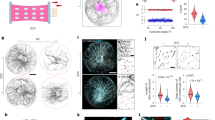Abstract
Studies were carried out on the effects of disruption and stabilization of microtubules and microfilaments on the formation of neuronal plastic responses in isolated nerve cells of the molluskLymnaea stagnalis. Disruption of these cytoskeletal elements prevented the development of neuronal plastic responses. Microtubule stabilization produced a dynamic relationship between the development and retention of neuronal plastic responses and series of stimuli. Stabilization of microfilaments blocked the development but promoted the retention of these neuronal responses.
Similar content being viewed by others
References
P. M. Balaban, O. A. Maksimova, and N. I. Bravarenko, “Plastic forms of behavior in the edible snail and their neuronal mechanisms,” Zh. Vyssh. Nerv. Deyat.,42, No. 6, 1208 (1992).
L. Sh. Ganelina and T. P. Nekrasova, “Protein kinase C and its role in normal and transformed cells,” Tsitologiya,31, No. 2, 131 (1989).
D. A. Moshkov, Adaptation and the Ultrastructure of the Neuron [in Russian], Nauka, Moscow (1985).
A. S. Ratushnyak and T. A. Zapara, “The effect of microfilament stabilization on rearrangements of neuron responses,” Dokl. Akad. Nauk SSSR,318, No. 2, 492 (1991).
V. A. Tkachuk, “The role and place of cyclic nucleotides in the neuroendocrine regulation of cells and tissues,” Biol. Nauki, No. 6, 5 (1987).
Yu. V. Chistyakova and E. V. Parfenova, “Ca-Protease—an enzyme involved in the metabolism of cytoskeleton proteins in the olfactory pavement in vertebrates,” Tsitologiya, No. 11, 1345 (1989).
D. L. Alkon and H. Rasmussen, “A spatial-temporal model of cell activation,” Science,239, No. 4843 988 (1988).
Ch. Aoki and Ph. Siekevitz, “Ontogenetic changes in the cyclic adenosine 3,5-monophosphate-stimulatable phosphorylation of cat visual cortex proteins, particularly of microtubule-associated protein 2 (MAP2): effects of normal and dark rearing and of the exposure to light,” J. Neurosci.,5, No. 9, 2465 (1985).
V. Bennet, K. Gardner, and J. Steiner, “Brain adducin: a protein kinase C substrate that may mediate site-directed assembly at the spectrin-actin junction,” J. Biol. Chem.,263, No. 12, 5860 (1988).
D. Bigot and S. P. Hunt, “Effect of excitatory amino acids on microtubilin-associated proteins in cultured cortical and spinal neurons,” Neurosci. Lett.,111, No. 2, 275 (1990).
M. R. Costa and W. A. Catterall, “Cyclic AMP-dependent phosphorylation of the—subunit of the sodium channel in synaptic nerve-ending particles,” J. Biol. Chem.,259, No. 13, 8210 (1984).
M. R. C. Costa and W. A. Catterall, “Phosphorylation of the—subunit of the sodium channel by protein kinase C,” Cell. Molec. Neurobiol.,4, No. 3, 291 (1984).
S. A. Deriemer, et al., “Enhancement of the sodium current inAplysia neurons by phorbol ester and protein kinase C,” Nature,313, No. 600, 313 (1985).
D. A. Ewald, A. Williams, and I. B Levitan, “Modulation of single Ca-dependent K-channel activity by protein phosphorylation,” Nature,315, No. 6019, 503 (1985).
J. Farley and S. Aurbach, “Protein kinase C activation induces conductance changes inHermissenda photoreceptors like those seen in associative learning,” Nature,219, No. 6050, 220 (1986).
J. Fukuda, M. Kameyama, and K. Yamaguchi, “Breakdown of cytoskeletal filaments selectively reduces Na and Ca spikes in cultures mammal neurons,” Nature,294, No. 5, 82.
B. Hochner, et al., “Action-potential duration and the modulation of transmitter release from the sensory neurons ofAplysia in presynaptic facilitation and behavioral sensitization,” Proc. Natl. Acad. Sci. USA,83, No. 21, 8410 (1986).
J. T. Neary and D. L. Alkon, “Protein phosphorylation/dephosphorylation and the transient voltage-dependent potassium conductance inHermissenda crassicorus,” J. Biol. Chem.,258, No. 14, 8979 (1983).
E. J. Neer and D. E. Clapham, “Roles of G protein subunits in transmembrane signaling,” Nature,333, No. 6169, 129 (1988).
F. Noel, et al., “Long-term changes in synthesis of intermediate filament protein actin and other proteins in pleural sensory neurons ofAplysia produced by an in vitro analogue of sensitization,” Mol. Brain Res.,19, No. 3, 203 (1993).
L. S. Perlmutter, et al., “Distribution of calcium-activated protease calpain in the rat brain,” J. Comp. Neurol.,296, No. 2, 269 (1990).
A. S. Ratushnyak and T. A. Zapara, “Experimental analysis of mechanisms of information fixation by means of molecular neuroprocessor,” in: Molecular Electronics, P. I. Lazarev (ed.), Kluwer Academic Publishers, Netherlands (1991), p. 219.
C. Rosenmund and G. L. Westbrook, “Calcium-induced actin depolymerization reduces NMDA channel activity,” Neuron,10, No. 5, 805 (1993).
M. H. Wolf, et al., “A model of intracellular translocation of protein kinase C involving synergism between Ca and phorbol esters,” Nature, No. 317, 546 (1985).
T. A. Zapara, A. S. Ratushnyak, and M. B. Shtark, “Local changes of transmembrane currents at plastic reorganizations of electrogenesis of isolated neurons of the snail,” Neurosci. Behav. Physiol.,19, No. 3, 140 (1989).
Additional information
Institute of Computer Technology, Russian Academy of Sciences, Siberian Branch, Novosibirsk. Translated from Zhurnal Vysshei Nervnoi Deyatel'nosti, Vol. 46, No. 2, pp. 355–362, March–April, 1996.
Rights and permissions
About this article
Cite this article
Ratushnyak, A.S., Zapara, T.A., Zharkikh, A.A. et al. Effects of changes in dynamic equilibrium in microtubule and microfilament systems on the plastic responses of neurons. Neurosci Behav Physiol 27, 353–359 (1997). https://doi.org/10.1007/BF02462935
Received:
Accepted:
Issue Date:
DOI: https://doi.org/10.1007/BF02462935




